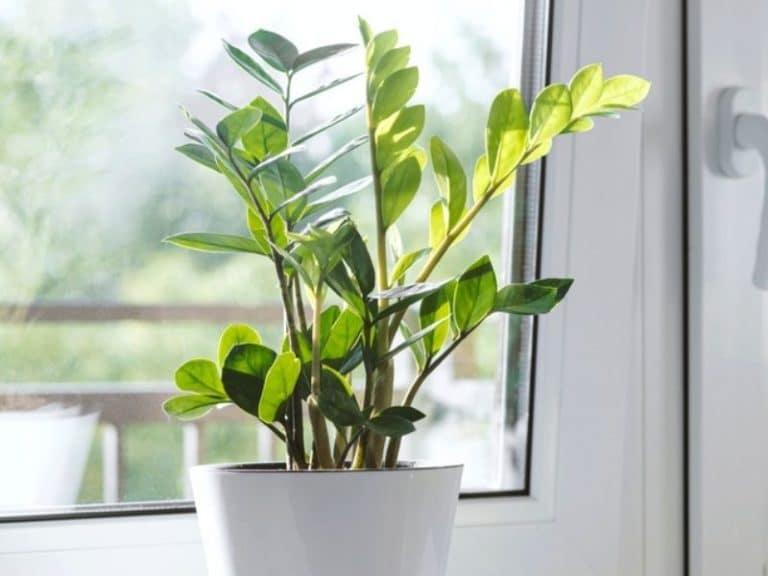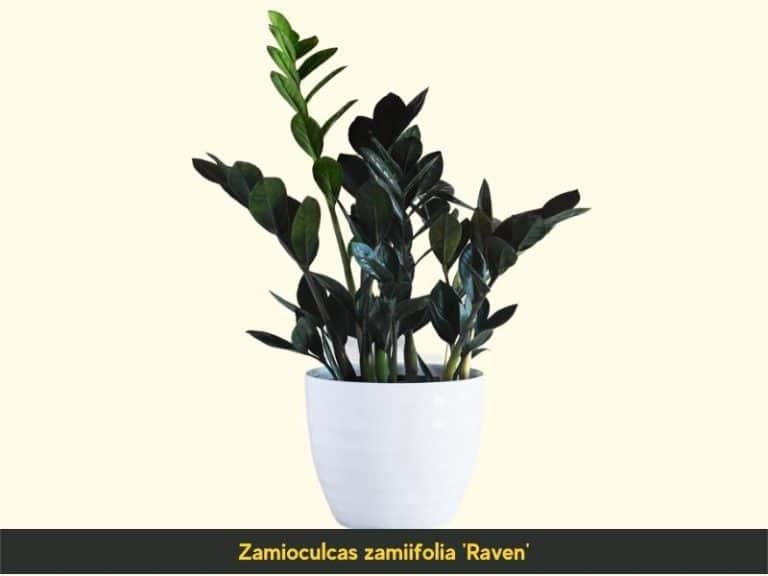Yellow ZZ plant Leaves – Causes and Fixes
A ZZ plant requires minimal care but when neglected and not well-taken care of, its leaves will easily turn yellow or brown, curl, and dull. When the foliage becomes yellow, it is a sign something is wrong and the plant needs proper mitigation to survive.
A ZZ plant’s leaves turn yellow due to poor light, overwatering, root rot disease, too much fertilizer, or lack of drainage holes in the pot. To fix the yellowing, cut off rotting roots then repot the plant in a well-draining soil mix. Also, allow the ZZ plant’s soil to dry out between waterings.
To successfully fix the yellowing and restore the plant’s green color and health, you want to make sure you identify the exact cause and apply the right fix for it as I’ve explained below.
Why are the leaves on my ZZ plant turning yellow?

Your ZZ plant may become yellow when it is stressed. As the plant matures, you will notice yellow leaves especially at the bottom of the plant. There’s no need to worry if just a few old leaves are turning yellow. Other factors may also contribute to discoloration.
Here’s why zz plant leaves turn yellow:
Overexposure to direct sunlight
ZZ plants prefer low-to-moderate light to grow happy and healthy. The low-light requirements make them perfect houseplants in dark spaces. Exposing them to the scorching sun may cause yellowing and burning in leaves.
Here’s how to diagnose if the yellow leaves are caused by overexposure to sunlight:
- Examine the leaves for sunburn spots
- Move the plant to an area with low lighting. Cover the window with blinds or sheer curtains to prevent direct sunlight if it’s next to an east-facing window.
- Move it under a shade-like structure like your patio or a tree if it’s an outdoor ZZ.
Salt burn from overfertilization
Not fertilizing your ZZ enough or overfertilization can cause nutrient imbalances, leading to yellow leaves. The plant needs to be fed once a month with dilute water-soluble fertilizer during its growing season (between April and August).
Overfertilization means you’ve applied fertilizer more than once a month. Excess salts can easily cause burns.
Under-fertilization means you’ve fertilized the plant only once per year, or not all. However, ZZ plants can survive in soils with poor nutrients. Even if you haven’t applied fertilizer, nutrient deficiency is unlikely.
However, when it happens, it can cause yellow foliage.
Pest infestation
ZZ plants under stress due to nutrient deficiency or overwatering are susceptible to pests like spider mites and mealybugs. These pests suck on the sap of a ZZ’s leaves, draining it of moisture. When left uncontrolled, these bugs will move along the leaves and fronds, further weakening the plant.
Start by examining the underside of the leaves to spot the pests hiding underneath them. You should also see holes on the leaves, indicating that pests have been sucking into the plant’s sap. Identifying the specific bug before administering pest control solutions is the easiest way to redeem your ZZ.
Overwatering
Yellowing is a major problem stemming from improper ZZ plant care especially to do with watering. ZZ plants don’t need daily or weekly watering because they’re drought resistant. Their rhizomes store enough water to keep it hydrated for up to two weeks in summer and three weeks in winter. Overwatering prevents their roots from utilizing nourishment properly. You’ll know your ZZ is yellowing due to overwatering by:
- Checking the top half soil for dampness
- Checking the rhizomes to detect possible rot issues. They’ll be mushier and emit a rotten smell.
- The type of pot. Pots made from plastic materials without holes are more prone to overwatering because they can store water for long.
Underwatering
While ZZs can tolerate drought, underwatering can cause their leaves to turn yellow, droop, or shrivel. If you suspect your plant is turning yellow due to dehydration, do the following:
- Examine the leaves for wrinkles and shriveling
- Check the first three inches of topsoil to determine if it’s completely dry
A yellowing ZZ plant can bounce back to greenness once its roots receive water first.
How to Fix Yellow ZZ Plant Leaves
Whether the yellowing in your ZZ plant is due to stress or a coping mechanism for surviving aging symptoms, restoring its greenness is easy. Depending on what caused the yellowing, you can make it green again by:
1. Water the plant once a week when the soil dries up
ZZs need water no more than once every two weeks in summer and three weeks in winter. They don’t need a lot of water, nor can they survive prolonged periods of drought. Restoring its greenness after overwatering works by:
- Repotting it in an ideal-sized pot (preferably terra cotta, concrete, or coir). Ensure the pot is two inches in diameter than your plant to prevent its roots from struggling for nutrients.
- Pour water through the soil like you would do with a cactus or succulent. Add water until the pot starts draining off excess water to a water pan or saucer.
- Repotting in a fast-draining soil mix (organic potting soil, perlite, horticultural charcoal, and orchid bark).
- Maintain a good watering schedule. If you overwater in between waterings, it may suffer a shock, leading to yellow leaves. Water it (top inch of soil) every two weeks in summer and three weeks in winter.
2. Quarantine the ZZ plant and kill the pests
Should your ZZ suffer pest infestation and you’ve already identified the culprit involved, take the following actions:
- Quarantine it. Move the pot away from the pest-infested area
Clean the leaves with water to displace the bugs. Remember, a pest-infested ZZ plant is poisonous to humans and pets. Ensure you wear gloves, goggles, and a dust coat to keep the plant from accessing your skin due to prolonged exposure.
- Spray the leaves with neem oil or any pesticide approved for controlling the specific pest after correctly identifying it
3. Move the plant to a place with low-to-moderate lighting
If you placed the plant near a window inviting direct sunlight, it’s time to move it to a darker room. If this isn’t an option, place the pot near a window covered with blinds or sheer curtains to prevent direct light from accessing it. If you’re growing it outdoors, move it to a shaded place like under a tree or the patio.
4. Flush excess salts from the soil
If you’re certain that your plant is reacting to fertilizer burn, take these measures:
- Flush out the soil with a lot of water to remove excess salts/ dilute the fertilizer
- Repot it in fresh soil mix
If you believe that it’s yellowing due to nutrient deficiency, try applying the once-a-month dilute and water-soluble fertilizer during the growing season.
Will yellow ZZ leaves turn green again?
ZZs are known to be low maintenance and can survive neglect. However, leaves turning yellow signifies prolonged neglect and unfavorable growing conditions. Your ZZ can turn green again after identifying and fixing the real cause of yellowing. Your next course of action should involve providing the right conditions for the plant to thrive.
This plant’s ideal conditions include:
- Low-to-moderate light, not direct sunlight exposure
- A once-per-two-weeks deep watering in summer and every three weeks in the winter. The soil should be totally dry before watering. Don’t allow it to stand in water.
- They prefer temperatures ranging between 65 °F and 85 °F
Should you trim the yellow leaves?
Zanzibar gems belong among the slowest growing houseplants. It can take between three to five years or more for an adult ZZ to grow 3-4-feet tall and 3-feet wide. Its growth rate depends on how much light, nutrients, and water it receives. Considering how long it takes to grow, deciding when the time is right for pruning can be daunting.
However, pruning your ZZ may come in handy if:
- It’s diseased
- Has damaged foliage
- It has long stems.
Reasons for trimming a ZZ plant include:
You want to make it look more symmetrical
Some stems in your ZZ plant may overtake the rest, making it appear asymmetrical. Trimming not only restores its symmetrical appearance but also helps it restore more energy to produce smaller stems.
You want to get rid of old and dead leaves
Like other plants, aging ZZ leaves may wilt and die as it keeps growing. While you may expect them to fall, these leaves may sometimes hold on to the plant, robbing other parts of essential nutrients. Furthermore, these leaves may spread diseases to other parts of the plant. Prevent that from happening by trimming the dead leaves.
Preventing diseased stems or leaves from affecting healthier parts of the plant
Overwatering your ZZ invites issues like rotting, which may spread to other healthier parts of the plant. Once you notice mushy tissues with a foul smell on the stems or leaves, trim them immediately.
Fixing leggy growth
Leggy growths indicate that the plant has been in a dark place for long. The first measure to take is moving it to place with indirect light. Proceed to prune the leggy growths to restore other plant parts’ energy to grow healthy.
Pro tips for trimming your ZZ plant
- Plan the trimming in early spring when the plant is almost out of dormancy
- Use a sterilized (dubbed with alcohol) gardening shear or scissors
- Inspect the soil for rotting before pruning the plant
- Prune diseased or old leaves where they meet at the stem
- Prune injured stems from where the damage begins
References
- Michigan State University, Department of Horticulture: ZZ plant is an easy tough indoor use




